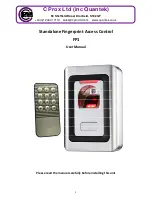
AES Module Programming Guide
677
SLAU723A – October 2017 – Revised October 2018
Copyright © 2017–2018, Texas Instruments Incorporated
Advance Encryption Standard Accelerator (AES)
1. When the device has been initialized, following the initialization sequences described in
and
, the application can enable the AES module interrupts through the AES Interrupt
Enable (AES_IRQENABLE) register, offset 0x090. If all four interrupts must be enabled, the application
can write 0x0000.000F to the AES_IRQENABLE register.
2. Load the input buffers, AES_DATA_IN_n, with data.
NOTE:
If the application uses Interrupt Mode, an interrupt is generated for each block of processed
data. To support larger data flow, AES µDMA Mode should be used and the bits in the
AES_IRQENABLE register should be cleared.
9.4.1.3.3 AES DMA Mode
When AES DMA Mode is enabled, the AES_IRQENABLE register should be cleared. To enable the µDMA
to transfer data follow these steps:
1. When the AES module has been initialized, enable the AES module µDMA channels by programming
the DMA Channel Map Select n (DMACHMAPn) register in the µDMA module. Further µDMA
configuration guidelines are available in the
.
2. Configure the dma_done interrupts by programming the AES DMA Masked Interrupt Status
(AES_DMAMIS) register, at CCM offset 0x028.
3. Enable the µDMA channels in the AES by programming the µDMA enable bits in the AES System
Configuration (AES_SYSCONFIG) register, offset 0x084.
4. The input buffer registers, AES_DATA_IN_n, at offsets 0x060 to 0x06C, are loaded.
9.4.1.4
AES Events Servicing
9.4.1.4.1 Interrupt Servicing
This section describes the event servicing of the module.
shows the AES interrupt service. The
registers used during event servicing are as follows:
•
AES_IRQSTATUS
•
AES_KEY1_n
•
AES_KEY2_n
•
AES_IV_IN_n
•
AES_DATA_IN_n
•
AES_TAG_OUT_n
•
AES_IRQENABLE
















































